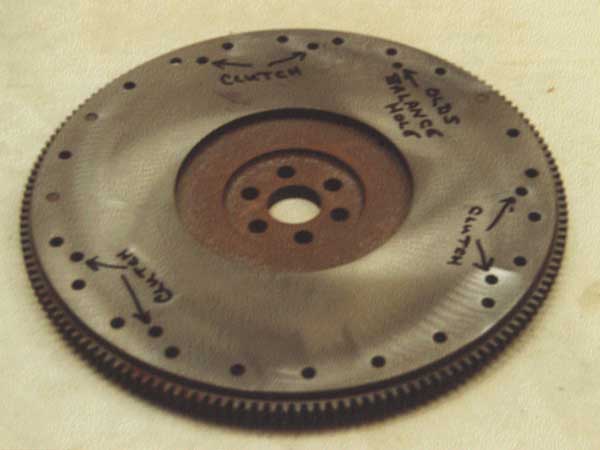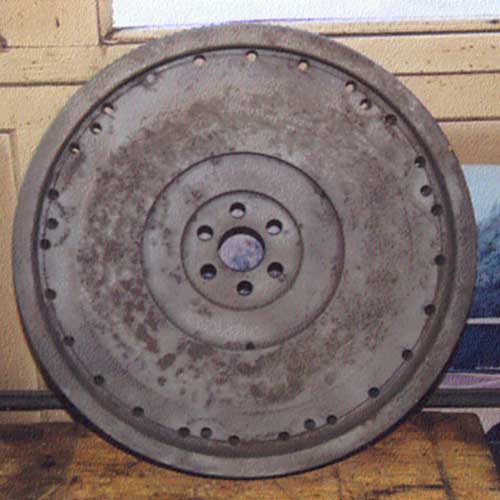�

�
Oldsmobile "Light" version (extra balance hole is highlighted)�
Buick and Oldsmobile 215 Flywheels
� This article appeared in The British V8 Newsletter - Volume XIII, Issue 3 - September 2005��
�
by: Kurt Schley�
�
� The OEM Buick and Oldsmobile 215 flywheels are very similar. All were manufactured from � cast iron. The flywheels are 13.10" in diameter (not including the ring gear) and are � drilled for the Long style 9-1/2" clutch with three pairs of 5/16 - 18 tapped holes on � a 10-7/8" bolt circle. (The exception is the Oldsmobile Jetfire flywheel with a 11-3/8" � bolt circle.) The flywheel i.d. at the crankshaft is 1.34" , inside of 6 each 0.47" � diameter clutch to flywheel bolt holes on a 2.32" bolt circle. One of these six holes � is offset slightly so that the flywheel can be mounted to the crankshaft in only one � position, facilitating balancing. The friction surface to mate with the clutch disc is � 10.00" for all except the Jetfire, which had a 10-1/2" clutch disc. The flywheels also � are drilled with 1/4" diameter through holes at a 45° angle, located near the mounting � bolt holes. These holes were to vent fumes and gases generated by the friction between � the clutch disc and the flywheel. The Buick flywheels have three of these holes and the � Oldsmobile units have two.�
��
All of the OEM 215 flywheels were individually balanced. Around the circumference of �
the flywheels were drilled a ring of 24 equally spaced holes on a 11.18" diameter �
circle. The balancing procedure was a two phase procedure. After an initial spin on �
the balancing machine, one or more metal pins were inserted into the ring of holes on �
the flywheel periphery, if necessary, and staked permanently into place. This placed �
the flywheel into a neutral or balanced state. The flywheel was then attached to the �
crankshaft and the assembly spun again. If any imbalance in the flywheel/crankshaft �
combination was present, additional balancing pins were installed as necessary. The �
second set of pin(s) is a press fit and can be removed.�
�
If the original flywheel on a 215 is damaged or worn, a replacement flywheel of identical �
type can be installed without the need for balancing at a machine shop. Merely remove �
the un-staked pins from the old flywheel and install them in the exact same location in �
the replacement (If there were un-staked pins in the replacement flywheel remove them �
before transferring pins from the old flywheel!) Do not attempt to transfer the staked �
pins. Use the offset crankshaft attachment bolt to position the two flywheels identically �
and determine the proper pin locations.�
�
Buick - Buick employed two styles of manual flywheels, a light and heavy version. The �
"light" version weighs in at only 23 lbs. and is flat faced on the clutch side. This �
flywheel was supplied only in the 2-door 3-speed sedans which, because of their relatively �
light weight, did not require a heavier flywheel to get smoothly in motion from a stop. �
The balance of the Buick 215 powered cars, such as the 4-door coupes and the station �
wagons, were built with a beefier flywheel. The "heavy" version flywheel incorporated �
an integral cast inertial ring around it's circumference which boosted the weight to �
32 lbs.�
�
Oldsmobile - The Oldsmobile 215 flywheel inventory included two which were very similar �
to the Buick versions, plus an intermediate weight flywheel for use in the turbocharged �
Jetfire and in Oldsmobile sedans supplied to police departments. The reduction in weight �
was accomplished by machining of the inertia ring of a "heavy" version flywheel down to �
only a 1/4" width. In addition to its weight, the intermediate flywheel was unusual in �
that it was drilled for a 10-1/2" clutch. Oldsmobile engineers figured that the Jetfire's �
210HP and constant abuse of police patrols suggested need for a larger clutch to provide �
an acceptable service life.�
| �
Enjoying this article? Our magazine is funded through the generous support of readers like you! � To contribute to our operating budget, please click here and follow the instructions. � (Suggested contribution is twenty bucks per year. Feel free to give more!)� |
� The drivetrain engineers at Oldsmobile also incorporated a refinement which physically � differentiates the Olds from the Buick flywheels. Early testing of the 215 engine revealed � a very slight rocking motion when idling. Numerous tests determined that this movement � could be eliminated by drilling a single additional balancing hole 0.25" diameter x 0.7" � in depth in the flywheel, 5.32" from the center of the flywheel and just inboard of the � standard ring of balance pin holes. The Oldsmobile harmonic balancer was redesigned to � incorporate a small cast-in rib whose weight offset that lost to the flywheel's balancing � hole. The slight imbalance induced by the hole in the flywheel worked in synergy with the � redesigned harmonic balancer to eliminate the engine rock and afford an overall smoother � running engine.�
�� Pontiac - To accommodate the 215-powered Pontiac Tempest's unusual drivetrain, a flywheel � unique to the Tempest was designed. This flywheel was flat-faced and heavy at 40 lbs. � Unlike the Long-style clutch drilling used by Buick and Olds, the Pontiac flywheel is � drilled for a Borg and Beck clutch. Flywheel Ring Gear - The flywheel ring gear was � manufactured with 156 teeth and is a shrink fit on the flywheel which makes replacement � relatively easy. To remove a worn or damaged ring gear, two 3/16" holes are drilled, one � side to side between two teeth and another intersecting hole from the outside in, and the � gear is split at the holes with a sharp chisel. The new ring gear is then heated with a � torch or in the oven to expand its diameter. While hot, the gear is pressed onto the � flywheel, making sure that it is aligned with the flywheel face and with the chamfered � edge of the ring gear against the flywheel shoulder. OEM specifications call out that � the ring gear must withstand 28,000 inch/pounds of torque without slipping.�
�| Partial List of General Motors 215 Flywheel Part Numbers: | ||
| Year | Model | Part Number |
| 1961 | F85 Manual transmission (except Heavy Duty models) | 578340 � |
| 1961 | F85 Manual transmission (Heavy Duty models) | 583061 � |
| 1961/62 | F85 (except Jetfire) | 586998 � |
| 1962 | F85 Police and Taxi | 588457 � |
| 1962 | Jetfire | 588457 � |
| 1961/62 | Special | 1199441� |
�
Buick 300 Flywheel:
�
* Drilled for Borg-Warner clutch, 3 equally spaced 3/8-16 UNC holes on 11-5/8" bolt circle
�
* 6 ea. 0.46" diameter flywheel-to-crank bolt holes on 3.580" bolt circle
�
* 3 ea. vent holes
�
* 166 tooth ring gear�
�

Oldsmobile "Light" version - backside
�

Heavy Buick Flywheel
�
(editor's note: that ring around the outer edge is even deeper than it appears in the photo)
�
� Disclaimer: This page was researched and written by Kurt Schley. Views expressed are � those of the author, and are provided without warrantee or guarantee. Apply at your own risk.�
�
